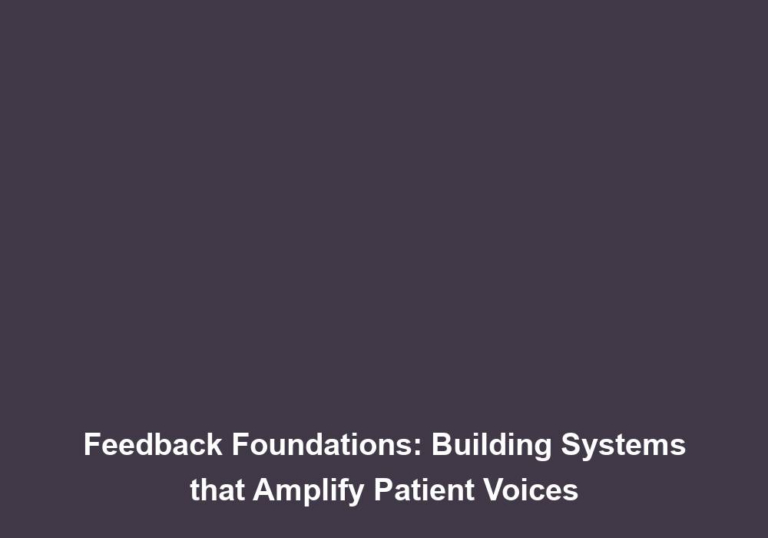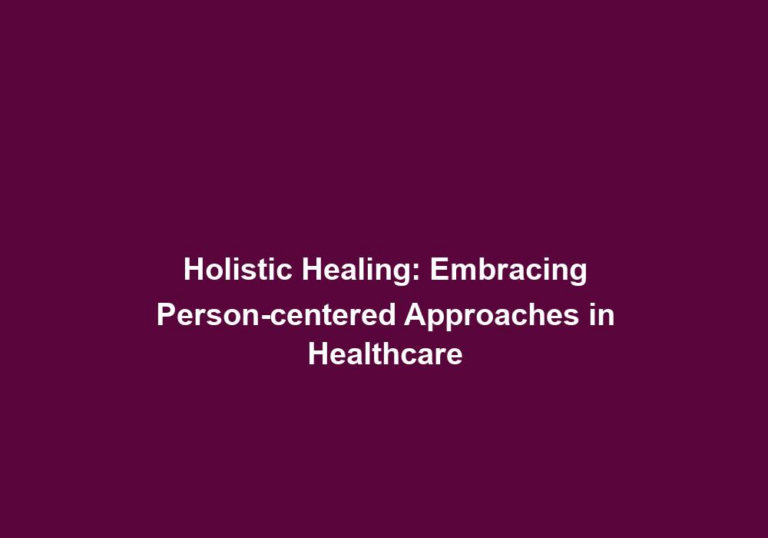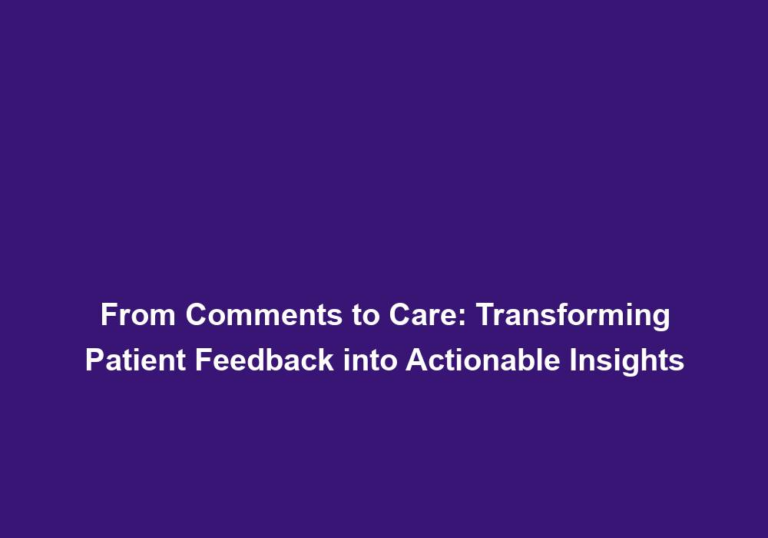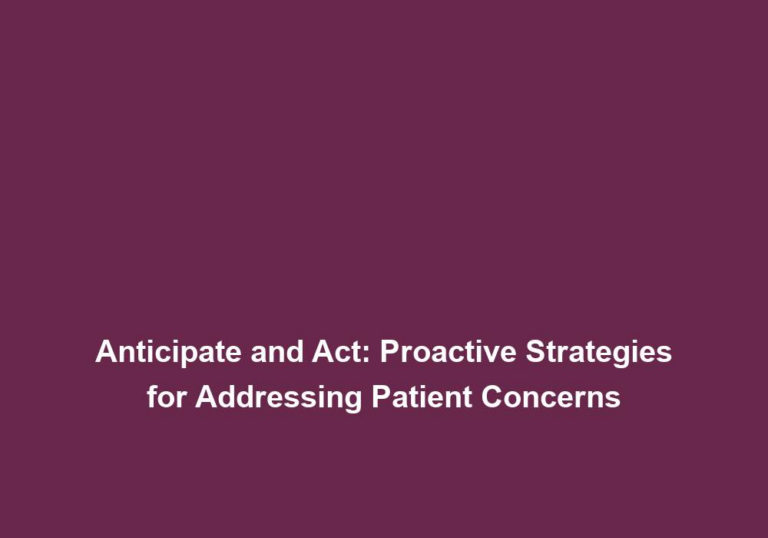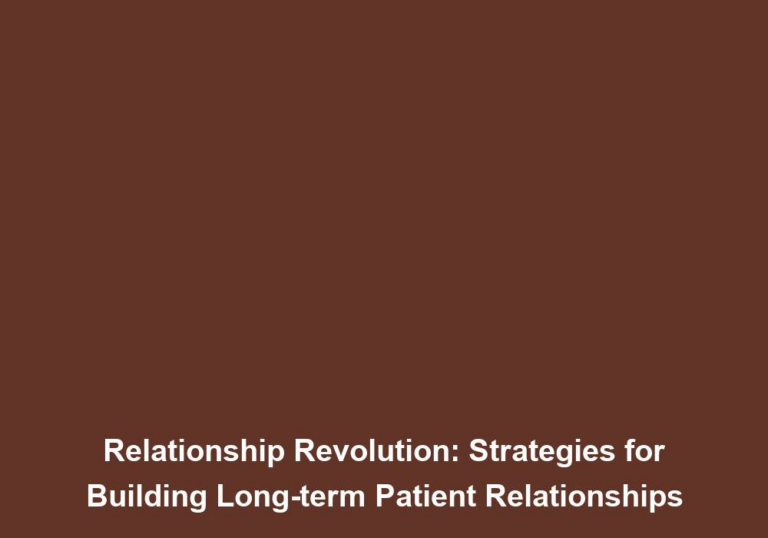Hearing to Heal: Implementing Effective Patient Feedback Systems
In the healthcare industry, patient feedback plays a crucial role in improving the quality of care and services provided. Implementing an effective patient feedback system is essential to ensure that healthcare organizations can identify areas of improvement, address concerns, and ultimately enhance patient satisfaction. This article aims to explore the significance of patient feedback and provide guidance on implementing a comprehensive and successful system.
The Importance of Patient Feedback
Patient feedback serves as a valuable source of information, allowing healthcare providers to gain insight into the patient experience. By actively listening to their patients, healthcare organizations can identify strengths, weaknesses, and areas for improvement within their systems and processes. Here are some key reasons why patient feedback is essential:
- Enhancing Quality of Care: Patient feedback provides healthcare organizations with valuable insights on how to improve the quality of care they deliver. By understanding patients’ needs, concerns, and preferences, healthcare providers can tailor their services to meet expectations and deliver a higher standard of care.
-
Patient feedback helps identify specific areas where improvements can be made, such as reducing waiting times, improving communication between healthcare providers and patients, and enhancing the overall patient experience.
-
By addressing these specific areas, healthcare organizations can ensure that the care they provide is patient-centered and aligned with the unique needs of each individual.
-
Implementing patient feedback systems also allows healthcare providers to monitor the effectiveness of any implemented changes and make further adjustments if necessary.
- Improving Patient Satisfaction: Satisfied patients are more likely to have better health outcomes and remain loyal to healthcare providers. By actively seeking and implementing patient feedback, organizations can enhance patient satisfaction levels, leading to improved patient retention and positive word-of-mouth referrals.
-
Patient feedback helps healthcare organizations understand what aspects of their services are working well and what areas may need improvement. By addressing any concerns or issues raised by patients, organizations can improve overall patient satisfaction.
-
By consistently seeking patient feedback, healthcare providers can demonstrate their commitment to continuous improvement and patient-centered care. This fosters a sense of trust and engagement between healthcare providers and patients, further enhancing patient satisfaction.
-
Improved patient satisfaction not only benefits individual patients but also contributes to the reputation and success of healthcare organizations.
- Identifying Service Gaps: Patient feedback helps identify gaps in service delivery, allowing healthcare providers to address any shortcomings promptly. Identifying and rectifying these gaps can lead to enhanced operational efficiency and overall patient experience.
-
By actively seeking feedback, healthcare organizations can identify areas where their services may be falling short of patient expectations. This can include factors such as long wait times, lack of communication, or inadequate facilities.
-
Addressing these service gaps can improve operational efficiency by streamlining processes and reducing bottlenecks. It can also lead to a more positive patient experience, as patients feel their needs are being met and their concerns are being addressed.
-
Regularly analyzing patient feedback can help healthcare providers identify trends or patterns in service gaps, allowing for targeted interventions and continuous improvement.
- Building Trust and Engagement: By actively seeking patient feedback and acting upon it, healthcare organizations demonstrate their commitment to patient-centered care. This fosters trust, enhances patient engagement, and strengthens the relationship between healthcare providers and patients.
-
When patients see that their feedback is valued and acted upon, they feel more engaged in their own healthcare journey. This can lead to improved compliance with treatment plans and better health outcomes.
-
Actively seeking and implementing patient feedback also shows transparency and accountability on the part of healthcare organizations. This can help build trust between healthcare providers and patients, leading to stronger patient-provider relationships.
-
Building trust and engagement through patient feedback can also result in increased patient loyalty and positive word-of-mouth referrals, benefiting the reputation and success of healthcare organizations.
Implementing an Effective Patient Feedback System
To implement an effective patient feedback system, healthcare organizations need to consider several key components and strategies. By following these guidelines, healthcare providers can ensure a comprehensive feedback system that promotes patient engagement and drives continuous improvement.
1. Establish Clear Objectives and Goals
Before implementing a patient feedback system, it’s crucial to define clear objectives and goals. Determine what you aim to achieve through patient feedback, whether it’s improving patient satisfaction, identifying operational inefficiencies, or enhancing specific aspects of care delivery. Clear objectives will guide the design and implementation of the feedback system.
-
Clearly define the specific goals you want to achieve through patient feedback, such as reducing patient complaints by a certain percentage or improving patient satisfaction scores.
-
Align your objectives with the overall mission and vision of your healthcare organization to ensure that the feedback system supports your organizational goals.
-
Consider involving key stakeholders, such as healthcare providers, administrators, and patients themselves, in the process of defining objectives to ensure a comprehensive and inclusive approach.
2. Choose the Right Feedback Methods
There are various methods healthcare organizations can employ to collect patient feedback. Some common approaches include:
-
Surveys: Conducting surveys, either online or on paper, allows patients to provide structured feedback on their experiences, satisfaction levels, and suggestions for improvement.
-
Use a combination of closed-ended and open-ended questions to gather both quantitative and qualitative data. Closed-ended questions provide specific data points, while open-ended questions allow patients to express their thoughts and ideas in their own words.
-
Consider using validated survey instruments or standardized questionnaires to ensure the reliability and validity of the data collected.
-
Focus Groups: Organizing focus groups with a diverse range of patients can provide valuable qualitative insights into their experiences and opinions.
-
Select a representative sample of patients to participate in the focus groups, ensuring diversity in terms of age, gender, ethnicity, and socioeconomic status.
-
Use a structured approach to guide the discussion, focusing on specific topics or areas of interest.
-
Encourage open and honest communication among participants to gather rich and detailed feedback.
-
One-on-One Interviews: Conducting individual interviews with patients allows for more personalized and in-depth feedback, enabling healthcare providers to gain a deep understanding of patients’ needs and concerns.
-
Use a semi-structured interview guide to ensure consistency while allowing flexibility to explore specific topics or issues raised by patients.
-
Create a comfortable and confidential environment that encourages patients to share their experiences and concerns openly.
-
Actively listen to patients during the interviews, demonstrating empathy and respect for their perspectives.
-
Online Feedback Portals: Implementing online platforms where patients can easily submit feedback provides a convenient and accessible channel for communication.
-
Ensure that the online feedback portal is user-friendly, intuitive, and accessible to all patients, including those with limited technological proficiency.
-
Consider implementing mechanisms to ensure the confidentiality and privacy of patient feedback, such as anonymous submission options.
-
Regularly monitor and respond to feedback submitted through the online portal to demonstrate responsiveness and engagement.
Choose the feedback methods that align with your objectives, budget, and patient demographics.
3. Train Staff on Effective Communication Skills
To ensure the success of a patient feedback system, healthcare organizations must train their staff on effective communication skills. Staff members should be trained to actively listen to patients, demonstrate empathy, and respond appropriately to feedback. This will create an environment where patients feel comfortable sharing their experiences and concerns.
-
Provide training on active listening techniques, such as maintaining eye contact, using open-ended questions, and avoiding interrupting or rushing patients.
-
Train staff members to demonstrate empathy and understanding when interacting with patients, acknowledging their emotions and concerns.
-
Teach effective communication strategies, such as paraphrasing and summarizing patient feedback to ensure accurate understanding.
-
Foster a culture of open communication within the healthcare organization, encouraging staff members to actively seek and value patient feedback.
4. Implement Real-Time Feedback Mechanisms
Real-time feedback mechanisms allow patients to provide feedback immediately after an interaction or experience. This can include digital platforms or mobile applications that enable patients to share their feedback conveniently. Real-time feedback provides timely insights, enabling healthcare providers to address concerns promptly and make necessary improvements.
-
Implement digital feedback platforms that allow patients to provide feedback in real-time, such as through mobile apps or online portals.
-
Ensure that the feedback mechanisms are user-friendly and intuitive, requiring minimal effort and time from patients to provide feedback.
-
Regularly monitor and analyze the real-time feedback data to identify trends or patterns that require immediate attention.
-
Use the real-time feedback data to make timely improvements, such as addressing individual patient concerns or adjusting processes and procedures.
5. Analyze and Act on Feedback
Collecting patient feedback alone is not enough. Healthcare organizations must establish a structured process for analyzing and acting upon the received feedback. This involves categorizing feedback, identifying recurring themes, and prioritizing areas for improvement. Regularly review feedback data and implement actionable changes based on the insights gained.
-
Develop a standardized approach to analyze patient feedback, such as categorizing feedback into themes or topics.
-
Use data analysis tools or software to identify recurring patterns or trends in the feedback data.
-
Prioritize areas for improvement based on the severity of the issues raised, the frequency of occurrence, and the potential impact on patient satisfaction.
-
Develop action plans to address the identified areas for improvement, assigning responsibilities and setting timelines for implementation.
6. Communicate Feedback Outcomes
Once improvements have been made based on patient feedback, it’s essential to communicate these outcomes to both staff and patients. Sharing how patient feedback has led to positive changes fosters transparency and demonstrates a commitment to continuous improvement. Communicating feedback outcomes also reassures patients that their voices are heard and valued.
-
Develop a communication plan to share feedback outcomes with staff and patients, using various channels such as staff meetings, newsletters, or patient portals.
-
Highlight specific improvements made based on patient feedback, linking them to the original concerns or issues raised.
-
Recognize and acknowledge the contributions of patients who provided feedback, showing appreciation for their engagement and participation in the improvement process.
-
Encourage ongoing feedback from staff and patients, emphasizing the importance of their voices in driving continuous improvement.
7. Regularly Evaluate and Update the Feedback System
An effective patient feedback system requires ongoing evaluation and updates. Regularly assess the performance and effectiveness of the system, and make necessary adjustments to ensure it aligns with evolving patient needs and organizational goals. Continuous improvement is vital for maintaining a successful feedback system and enhancing patient satisfaction.
-
Establish a feedback loop within the healthcare organization to gather input from staff members involved in the feedback system. Use their feedback to identify areas for improvement and implement necessary changes.
-
Conduct regular surveys or focus groups with patients to gather feedback on their experience with the feedback system itself. Use this feedback to identify areas where the system can be improved or streamlined.
-
Stay updated with advancements in technology and new feedback methods, considering their potential to enhance the feedback system and improve patient engagement.
-
Regularly review the objectives and goals of the feedback system to ensure they align with the evolving needs and priorities of the healthcare organization.
Conclusion
Implementing an effective patient feedback system is crucial for healthcare organizations to improve the quality of care, enhance patient satisfaction, and drive continuous improvement. By establishing clear objectives, choosing appropriate feedback methods, training staff on effective communication, implementing real-time feedback mechanisms, analyzing and acting upon feedback, communicating outcomes, and regularly evaluating the system, healthcare providers can create a robust feedback system that promotes patient engagement and ultimately leads to better patient outcomes.


